AKG C 319B User Manual
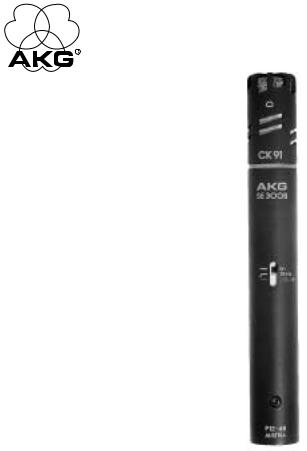
C 391B SE 300 B
Bedienungshinweise User Instructions Mode d’emploi Istruzioni d’uso Modo de empleo Instruções de Uso

Einleitung:
Das C 390 System ist ein Komplettsystem, das sich in höchst praktischer und wirtschaftlicher Weise den sich stets ändernden Erfordernissen der Schallplatten-, Rundfunk-, Beschallungsund Filmindustrie anpassen kann. Damit steht dem Tontechniker eine ganze Palette von Mikrofonmodulen zur Verfügung, die für jede erdenkliche Anwendung zu „maßgeschneiderten“ Mikrofonen mit Studioqualität kombiniert werden können.
Beschreibung:
Das C 390 System besteht aus einem Universal-Speiseteil/Ausgangs- modul (SE 300 B), 8 verschiedenen Mikrofonkapseln sowie leicht kombinierbaren Zubehörteilen, um allen Anwendungssituationen gerecht zu werden. Eine Übersicht des Gesamtsystems finden Sie auch am Schluß dieser Anleitung.
Die Hauptmerkmale des Systems sind:
•robuste Mechanik
•geringes Eigenrauschen
•geringer Strombedarf
•hohe Betriebssicherheit
•niederohmiger Kapselanschluß
•einwandfreie Funktion bis 60° C und 95 % relative Luftfeuchtigkeit
•eingebaute, schaltbare Abschwächung der Verstärkung um 10 dB (siehe Abb. 1)
•außergewöhnliche Langzeitstabilität
•trafolose Ausgangsstufe
•Speisung durch jede Phantomspeiseeinrichtung nach DIN 45596 möglich
•geringe Verzerrungen auch bei hohem Schalldruck
•eingebautes Baßfilter mit Einsatzpunkt des Filters bei ca. 100 Hz (siehe Abb. 1)
Abb. 1
2

Das C 391 B besteht aus folgenden Modulen und Teilen:
•SE 300 B Speiseteil/Ausgangsmodul
•CK 91 Mikrofonkapsel mit frequenzunabhängiger, nierenförmiger Richtcharakteristik
•W 90 Schaumstoffwindschutz
•SA 40 universeller Stativanschluß
Das Mikrofon ist aufgrund seiner leichten Membrane weitgehendst unempfindlich gegen Hantiergeräusche. Weitere Merkmale sind das Ganzmetallgehäuse und dadurch die geringe HF-Störungsanfälligkeit sowie der problemlose Betrieb unter nahezu allen Bedingungen aufgrund der konservativen und verläßlichen Konstruktion.
Die einschaltbare Abschwächung des Ausgangssignals um 10 dB wird insbesondere im Zusammenhang mit hohen Schalldrücken (bei Verwendung im Nahbereich von energiereichen Schallquellen) und bei Eingangsstufen von Verstärkern oder Mischpulten mit begrenztem maximalen Eingangspegel von Vorteil sein, da sonst bereits eine Übersteuerung dieser angeschlossenen Stufen erfolgt, ohne daß die Aussteuerfähigkeit des Mikrofons voll genutzt wird.
Die am Mikrofon einschaltbare Baßabschwächung hilft zusätzlich, Verzerrungen bei den tiefsten Frequenzen hintanzuhalten, die in unkontrollierter Weise z. B. durch Rumpeloder Windgeräusche auftreten können. Die Steilheit des Filters beträgt ca. 12 dB/Oktave, wobei die Eckfrequenz (–3 dB Punkt) bei ca. 75 Hz liegt.
Handhabung:
Die Kapseln sind durch einen einfachen Bajonettverschluß mit dem Speiseteil/Ausgangsmodul verbunden. Dies ermöglicht ein sicheres, rasches und problemloses Tauschen der unterschiedlichen Kapseln, auch ohne Sicht, z. B. in abgedunkelten Räumen.
Die Kapseln bzw. diverse Zubehörteile sind nur in einer Position mit dem Speiseteil zusammenführbar. Danach wird durch eine kurze und kräftige Rechtsdrehung, bei der auch ein deutliches „Klick“ hörbar wird, das Modul in seine Endposition gebracht (siehe Abb. 2a, 2b).
Durch eine kurze Linksdrehung ist das Kapselmodul ebenso wieder rasch vom Speiseteil lösbar.
|
|
|
Abb. 2a |
|
Abb. 2b |
|
|
|
3
Anwendungen:
Mit den von uns angebotenen Modulen und dem Systemzubehör kann auf eine Vielzahl von anwenderspezifischen Situationen eingegangen werden. Aus Platzgründen kann allerdings nur eine Auswahl davon nachfolgend angeführt werden.
A)Auswahl von Kapselmodulen, um sich an unterschiedliche akustische Verhältnisse und Aufgaben anzupassen:
CK 91 – Nierenmikrofonkapsel
Klassische Mikrofonkapsel mit nierenförmiger Richtcharakteristik; universell einsetzbar für alle Anwendungsgebiete, wo eine gute Dämpfung von hinten (180°) gefordert wird.
CK 92 – Kugelmikrofonkapsel
Mikrofonkapsel mit kugelförmiger Richtcharakteristik zum Einsatz bei Reportagen oder bei Chorund Sologesangsaufnahmen im Tonoder Fernsehstudio. Die Kapsel hat – physikalisch bedingt – keine abstandsabhängige Frequenzkurve (Naheffekt), was bei den angeführten Anwendungen meist von Vorteil ist.
CK 93 – Hypernierenmikrofonkapsel
Im Aufbau ähnlich der CK 91, jedoch ist die Kapsel akustisch auf eine gleichförmige Hypernieren-Charakteristik abgestimmt. Daraus resultiert ein höherer Bündelungsgrad gegenüber der Nierenmikrofonkapsel. Dies bietet Vorteile bei Mehrkanalaufnahmen durch bessere seitliche Trennung bzw. in der Beschallung durch eine erhöhte Rückkopplungssicherheit.
CK 94 – Achtermikrofonkapsel
Diese Mikrofonkapsel zeichnet sich durch eine besonders gute Schallausblendung von der Seite aus und kann deshalb vorteilhaft bei Interviews oder Dramaaufnahmen eingesetzt werden. Eine weitere Anwendungsmöglichkeit bietet sich durch die Verwendung eines zweiten Mikrofons der Serie mit Nieren-, Hypernierenoder Kugelcharakteristik, um als M/S-Kombination eingesetzt zu werden.
CK 97-O – Miniatur-Kugelmikrofonkapsel
Ein sehr universell verwendbares Miniaturmikrofon kleinster Abmessungen mit kugelförmiger Richtcharakteristik. Generell für Sprache, aber auch zur akustischen Abnahme von Musikinstrumenten geeignet.
4
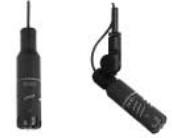
CK 97-C – Miniatur-Nierenmikrofonkapsel
Dieses Miniaturmikrofon ist überall dort einsetzbar, wo es darauf ankommt, daß das Mikrofon sich möglichst unauffällig ins Aufnahmegeschehen einfügt bzw. überhaupt nicht sichtbar sein soll. Trotzdem sorgt die Richtcharakteristik des Mikrofons dafür, daß die Aufnahme frei von überbetonter Räumlichkeit ist oder eine Beschallungsaufgabe mit guter Rückkopplungssicherheit erfüllt werden kann.
CK 98 – kurze Richtrohrkapsel
Diese Richtrohrkapsel stellt einen guten Kompromiß zwischen Richtrohrlänge und erreichter Richtwirkung dar. Auf diese Weise ist die Kapsel sehr gut für Tonaufnahmen bei Film und Fernsehen sowie für Anwendungen auf der Bühne und im Freien geeignet. Weiters überall dort, wo es auf deutliche Trennung einzelner Instrumente ohne zusätzliche akustische Trennwände ankommt.
B) Verwendung des Verlängerungskabelsets MK 90/3 + H 98
Dieser Zubehörteil ermöglicht es dem Toningenieur in Filmund Fernsehstudios oder Theatern, die relativ kleinen Mikrofonkapseln örtlich getrennt von den wesentlich größeren Mikrofon-Vorverstärkern über eine hochflexible Kabelverbindung einzusetzen. Einige Anwendungsbeispiele sind als Anregung nachfolgend abgebildet.
5
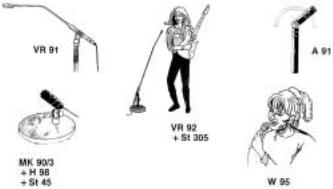
C)Der Einsatz des übrigen Systemzubehörs ist aus den folgenden Abbildungen erkennbar.
Mitgeliefertes Zubehör:
SA 40 Elastischer Stativanschluß
W 90 Schaumstoffwindschutz (nur bei C 391 B)
Empfohlenes Zubehör:
a) Systemzubehör:
A 91: Schwenkgelenk mit Schwenkbereich von ±90° von der Mikrofonachse
MK 90/3 + H 98: 3 m Adapterkabel einschließlich Stativanschluß/Aufhängevorrichtung
VR 91: 350 mm langes Verlängerungsrohr um alle Kapseln der Serie vom Speiseteil/Ausgangsmodul absetzen zu können
VR 92: wie VR 91, jedoch mit kurzem Schwanenhalsstück und 1,2 m lang
W 95: Ganzmetallwindschutz mit doppelter Schaumstoffauskleidung für die Kapseln CK 91, CK 92 und CK 93
6

b) Zubehör aus dem allgemeinen Lieferprogramm:
B 18: Batteriespeisegerät zum Betrieb von einem Mikrofon
H10: Ganzmetall-Stereoschiene mit verstellbarem Abstand zwischen den Mikrofonen von 35 bis 78 mm
H 30: Elastische Halterung mit sehr guter Dämmung
H38: Elastische Halterung zum Betrieb des Mikrofons auf Videooder Filmkameras
H 52: Stereo-Halterungsset zum optisch unauffälligen Stereobetrieb zweier Kapseln des Systems in XY (Koinzidenz), M/S- oder ORTFTechnik
N 62 E: Netzgerät zum Betrieb von 2 Mikrofonen N 66 E: Netzgerät zum Betrieb von 6 Mikrofonen
SA 18/1 B: Ganzmetall-Stativanschluß für besonders stabile Klemmung des Mikrofons
SA 38/H: Schwenkbarer Stativanschluß mit montierter elastischer Halterung H 38
St 45: Kleines Tischstativ
St 46: Kleines Tischstativ zum Betrieb der abgesetzten Kapseln
St 305: Schweres Tischstativ mit rundem Sockel und Gummiauflage zur Dämmung von Körperschall
Frequenzkurve: Polardiagramm:
Speisetechnik:
Der Speiseteil/Ausgangsmodul kann aus Phantomspeisequellen nach DIN 45596 gespeist werden. Diese Norm schreibt eine positive Spannung von 12, 24 oder 48 Volt an den NF-Leitungen gegen die Kabelabschirmung vor.
7
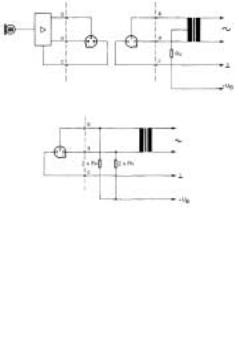
Folgende Anschlußschemata werden empfohlen:
1. Schaltung mit Eingangsübertrager mit Mittenanzapfung (erdfrei):
2. Schaltung mit Eingangsübertrager ohne Mittenanzapfung (erdfrei):
3.Sind die Verstärkereingänge geerdet oder keine Eingangsübertrager vorhanden, müssen entweder Kondensatoren oder zusätzliche Transformatoren in die NF-Leitungen eingefügt werden, um eine Beeinträchtigung der Eingangsstufe durch Leckströme zu verhindern.
Diese Schaltung kann sehr einfach und relativ preisgünstig in fast alle bestehenden Schaltungen nachträglich eingebaut werden und erspart die Anschaffung von externen Speisegeräten.
Normwerte für Rv (oder 2 x Rv) sind:
+ UB |
Rv |
2 x Rv |
12 V ± 2 V |
330 Ohm |
680 Ohm |
24 V ± 4 V |
680 Ohm |
1200 Ohm |
48 V ± 4 V |
3300 Ohm |
6800 Ohm |
8

Bemerkung:
Die Widerstände 2 x Rv sollten im Wert zumindest innerhalb von 0,5 % Toleranz sein, damit die geforderten Symmetriebedingungen erfüllt werden.
Reinigungshinweise:
Alle Oberflächen können von Zeit zu Zeit problemlos mit (Industrie-)- Spiritus oder Alkohol gereinigt werden. Der Schaumstoffwindschutz wird am besten mit einer milden Waschmittellösung gereinigt und ist sofort nach dem Trocknen wieder einsatzbereit.
Technische Daten des C 391 B:
Elektrische Arbeitsweise: |
Kondensatormikrofon, selbst- |
|
polarisiert |
Akustische Arbeitsweise: |
Druckgradientenempfänger |
Richtcharakteristik: |
Niere |
Übertragungsbereich: |
20–20.000 Hz ±2 dB von Sollkurve |
Feld-Leerlaufübertragungsfaktor |
10 mV/Pa – 40 dBV bez. auf |
(Empfindlichkeit) bei 1000 Hz: |
1 V/Pa |
Elektrische Impedanz: |
200 Ohm |
Empfohlene Lastimpendanz: |
1000 Ohm |
Ersatzgeräuschpegel nach |
|
DIN 45405 (CCIR 468-2): |
26 dB |
Äquivalentschalldruckpegel |
|
nach DIN 45412 (A-bew.): |
17 dB-A |
Geräuschpegelabstand |
|
bez. auf 1 Pa (A-bew.): |
77 dB |
Grenzschalldruck: |
80 Pa 132 dB für 1000 Hz, |
|
2000 Ohm Lastimpedanz und 1 % |
|
Klirrfaktor |
|
250 Pa 142 dB mit 10 dB Vorab- |
|
schwächung |
Betriebstemperatur: |
–20° C bis +60° C |
Relative Luftfeuchte: |
99% (+20° C), 95% (+60° C) |
Speisespannung: |
9–52 Volt nach DIN 45596 |
Strombedarf: |
2 mA |
Abmessungen: |
19 mm x 147 mm |
Gewicht: |
ca. 115 g netto |
Gehäusematerial: |
Messing |
9
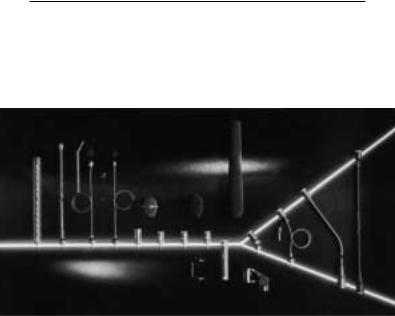
Gehäuseoberfläche: |
matt-grau |
Steckeranschluß: |
3pol. XLR-Stecker |
Steckerbeschaltung: |
nach IEC |
Dieses Produkt entspricht der Norm EN 50 082-1
Übersicht des Gesamtsystems:
10

Introduction:
The C 390 System is a completely modular system which can be adapted in a very practical and economical way to the always changing requirements encountered in the Recording, Broadcast, Sound Reinforcement, and Motion Picture Industries. The sound engineer has a choice of interchangeable condenser microphone modules which can be mixed and mated in various combinations to create custom studioquality microphones for any conceivable application.
Description:
The C 390 System consists of a single universal powering/output module, eight different microphone heads and various interchangeable accessory parts to match a great variety of applications. An overview of the complete system is shown at the end of this instruction booklet.
The following main features are provided:
•robust mechanical construction
•low self-noise
•low power consumption
•high operating reliability
•low impedance capsule connections
•will operate up to 60° C and over 95 % relative humidity
•built-in attenuation switch with 0 and – 10 dB position (see fig. 1)
•extended long-life stability
•transformerless output stage
•to be powered from any standard phantom powering source (acc. to DIN 45596)
•low distortion even at high sound pressure levels
•built-in bass-cut filter with onset at 100 Hz (see fig. 1)
Fig. 1
11

The C 391 B is delivered with the following modules and accessories:
•SE 300 B powering/output module
•CK 91 unidirectional microphone capsule with cardioid response
•W 90 foam-type windscreen
•SA 40 “quick release” stand adapter
The microphone features extremely low handling noise due to the lowmass diaphragm and smooth body finish, low r.f. interference due to screeningand filtering technique, and will work under almost any condition due to the conservative and reliable design.
The switchable attenuation of the output level by 10 dB is especially useful in connection with high sound pressure levels (when used in close proximity to high-energy sound sources) and using input stages of amplifiers or mixing desks with limited input level capabilities. Otherwise, this associated equipment will overload before the maximum overload point of the microphone has been reached. The incorporated bass-cut filter reduces the risk of distortion at low frequencies. This feature ist especially useful in combating wind noise or stage floor vibration. The slope of the bass-cut filter is about 12 dB/octave with the cut-off point at about 75 Hz.
Changing Modules:
All capsules may be attached to the powering module via a bayonet connection. Consequently, a quick, safe, and easy change of modules even in dark rooms may be made.
The capsules or accessory modules fit to the powering module in only one position. Once the two parts are put together only a short right-hand twist is required until the modul “clicks” into position (see figs. 2a, 2b). The capsule modules may be taken off from the powering module with a left-hand twist.
|
|
|
Fig. 2a |
|
Fig. 2b |
|
|
|
12
Applications:
The offered modules and the accessories of the system provide the user with the flexibility to work in a wide range of application areas. We can only list a limited selection because of space.
A)Selection of capsule modules to adjust to different acoustical situations:
CK 91 – Cardioid Microphone Capsule
A classic cardioid capsule suitable for all general purposes where a uniform front-to-back ratio is required.
CK 92 – Omnidirectional Microphone Capsule
This capsule is very suitable for chorus and soloist work in sound and tv studios. Reporters may also benefit from the inherent lack of proximity effect.
CK 93 – Hypercardioid Microphone Capsule
The design and construction is quite similar to the CK 91. The capsule is acoustically tuned to the hypercardioid polar response. The resulting higher directivity offers the advantage of better separation in multichannel recording work or improved gain before feedback in sound reinforcement situations.
CK 94 – Figure-eight Microphone Capsule
This capsule provides for high rejection of sound from the side (±90° off-axis) and is consequently well suited for interviews and dramas. In connection with a second microphone with cardioid, hypercardioid, or omni-directional response, an M/S combination can be easily formed and used.
CK 97-O – Miniature Omni-directional Capsule
A versatile miniature microphone of small dimensions with omnidirectional response. The capsule may be used generally for voice applications, but may also be used to record music instruments.
CK 97-C – Miniature Cardioid Microphone Capsule
This miniature microphone may be used wherever a microphone should not be seen in the recording scene. It has a uniform cardioid response and will provide recordings without excessive portion of reverberation.
13
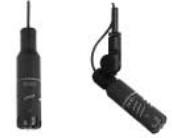
It will also provide for additional gain before feedback in sound reinforcement situations.
CK 98 – Short Shotgun Microphone Capsule
This capsule presents a good compromise between required length of the tube and the resulting directivity. The result will justify the operation of this microphone capsule in quite different application areas such as film, tv, stage, and video work. It will also work well where high acoustical separation between different instruments is required without having to erect acoustical dividers.
B) Using the cable set MK 90/3 + H 98
This accessory enables the sound engineer in film, tv, and theatre work to use the relatively small microphone capsules remotely from the substantially larger powering/output module via a highly flexible cable connection. The following illustrations show a few examples of how the cable set can be used.
14
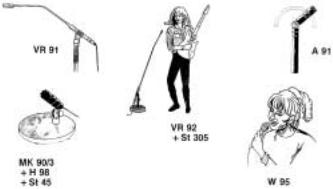
C)The application of the remaining accessories of the system is shown in the following illustrations
Enclosed Accessories:
SA 40 “quick release” stand adapter
W 90 foam-type windscreen (only provided with the C 391 B)
Optional Accessories:
a) Accessories of the C 390 system:
A 91: All-metal swivel joint with swivel range of ±90° from the microphone axis with intermediate stops
MK 90/3 + H 98: 3 m (10 ft.) cable set/stand adapter combination VR 91: 350 mm (14") angled extension tube
VR 92: 1.2 m (4 ft.) extension tube with short gooseneck at the capsule end. The VR 92 includes the stand adapter SA 18/1 B.
W 95: All-metal wire-mesh windscreen with double foam lining for the capsules CK 91, CK 92, and CK 93
b) Further optional accessories:
B 18: Battery power supply for one microphone
H10: Metal stereo crossbar with variable distance between the microphones from 35 to 78 mm (1 5/8" to 3")
H30: Elastic suspension with very effective damping of low-frequency rumble
15

H38: Elastic suspension especially suited for video/film camera mounting
H52: Stereo mount for inconspicuous operation of two capsules of the system in XY (coincidence), M/S, or ORTF-technique
N 62 E: AC power supply unit to feed two microphones N 66 E: AC power supply unit to feed six microphones
SA 18/1 B: All-metal stand adapter for specially stable mounting of the microphone
SA 38/H: Swivel stand adapter with integrated H 38 St 45: Slim table stand
St 46: Miniature table stand for microphone capsules
St 305: Heavy-duty, anti-shock table stand with circular base
Frequency Response Curve: |
Polar Response: |
||||||||||||||||||||||||||||||||||||||||||||||||||||||||||||
|
|
|
|
|
|
|
|
|
|
|
|
|
|
|
|
|
|
|
|
|
|
|
|
|
|
|
|
|
|
|
|
|
|
|
|
|
|
|
|
|
|
|
|
|
|
|
|
|
|
|
|
|
|
|
|
|
|
|
|
|
|
|
|
|
|
|
|
|
|
|
|
|
|
|
|
|
|
|
|
|
|
|
|
|
|
|
|
|
|
|
|
|
|
|
|
|
|
|
|
|
|
|
|
|
|
|
|
|
|
|
|
|
|
|
|
|
|
|
|
|
|
|
|
|
|
|
|
|
|
|
|
|
|
|
|
|
|
|
|
|
|
|
|
|
|
|
|
|
|
|
|
|
|
|
|
|
|
|
|
|
|
|
|
|
|
|
|
|
|
|
|
|
|
|
|
|
|
|
|
|
|
|
|
|
|
Powering Technique:
The powering/output module may be powered in phantom power technique according to DIN 45596. These standards specify a positive voltage on the audio lines versus the screen of the audio cable of 12, 24 and 48 volts.
The following wiring methods are suggested:
1.Circuitry incorporating an input transformer with centre tap (undergrounded)
16
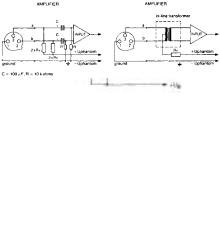
2.Circuitry incorporating an input transformer without centre tap (ungrounded)
3.In case where single ended (grounded) amplifier inputs, or where no input transformers are available, either capacitors or optional transformers have to be wired into the audio lines to prevent any current leakage into the input circuitry.
The components in the last figure may be easily and economically added to most existing input circuitries and would save the operation of external powering elements.
The following values for Rv (or 2 x Rv) are standardized:
+ UB |
Rv |
2 x Rv |
12 V ± 2 V |
330 ohms |
680 ohms |
24 V ± 4 V |
680 ohms |
1200 ohms |
48 V ± 4 V |
3300 ohms |
6800 ohms |
Please note:
The resistors 2 x Rv have to be at least of the 0.5 % tolerance type to satisfy the symmetry requirements.
Cleaning Hints:
All surfaces may be safely cleaned from time to time with methylated spirit or alcohol. The foam windscreen should be occasionally soaked in a non-aggressive detergent/water solution and will be ready for use after drying.
17
